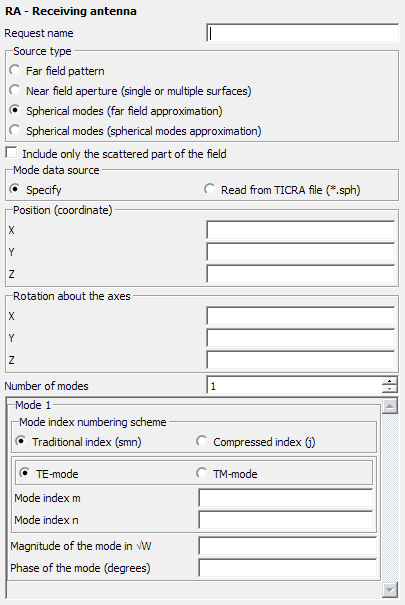Spherical Modes
This option defines an ideal receiving antenna with spherical modes.

Figure 1. The RA - Receiving antenna dialog.
Parameters:
- Request name
- The name of the request.
- Mode data source
- The spherical modes can be entered directly in the .pre file or it can be imported from a TICRA (.sph) file.
- Position (coordinate)
- The coordinates of the origin r = 0 of the mode in metres. These values are optionally scaled by the SF card.
- Rotation about the axes
- The rotation of the spherical mode source about the X, Y and Z axes.
- Number of modes
- Specify the number of modes that will be entered in the .pre file.
- Traditional index (smn)
- If this option is selected, you can specify TE-mode (s = 1) or TM-mode (s = 2) and the indices m and n in the group below. Here n is the mode index in the radial direction and must be in the range 1, 2, . . . and m is the mode index in the azimuth direction . There is no distinction between even and odd modes (with and angular dependencies), but rather use the angular dependency . Thus the index m can also be negative, but it must be in the range -n . . . n.
- Compressed index (j)
- With this option, a compressed one-dimensional mode numbering scheme is
used. The Mode index j is then specified as
where s = 1 for TE-mode and s = 2 for TM-mode. This unified mode numbering scheme allows the computation of an extended scattering matrix (with network and radiation ports). This index j then represents a unique port number in the scattering matrix.
(1) - Magnitude of the mode in
- Absolute value of the complex amplitude of this specific spherical mode (due to the applied normalisation of the spherical modes, the unit of this amplitude is = ).
- Phase of the mode (degrees)
- The phase of the complex amplitude of this spherical mode in degrees.
- Use all data blocks
- Import all data blocks from the specified TICRA (.sph) file. The data is interpolated for use at the operating frequency.
- Use only specified data block number
- Use the data from the nth frequency block in the TICRA (.sph) file.